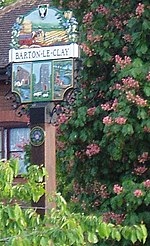Smithcombe, Sharpenhoe and Sundon Hills

Smithcombe, Sharpenhoe and Sundon Hills is an 86.1-hectare (213-acre) Site of Special Scientific Interest in Sharpenhoe in Bedfordshire. Most of it is a National Trust property comprising Sundon Hills, Moleskin and Markham Hills, Sharpenhoe Clappers and Smithcombe Hills. It is part of the Chilterns Area of Outstanding Natural Beauty, and Sharpenhoe Clappers is protected as a Scheduled Ancient Monument (for its prehistoric and medieval features).Much of the site is unimproved chalk grassland with many plants which are now rare, and Festuca ovina is dominant over large areas. Orchids include Herminium monorchis and Aceras anthropophorum. An uncommon rose, Rosa stylosa, is found in scrub areas. There is also beech forest with a ground layer including primroses.Clappers are rabbit warrens (from the French "clapier"), and meat, fur and leather from rabbits used to be an important part of the local economy. Sharpenhoe Clappers is an Iron Age hill fort, together with medieval rabbit warrens and associated agricultural earthworks.There is access to the National Trust property from Sharpenhoe Road.
Excerpt from the Wikipedia article Smithcombe, Sharpenhoe and Sundon Hills (License: CC BY-SA 3.0, Authors, Images).Smithcombe, Sharpenhoe and Sundon Hills
Barton Road,
Geographical coordinates (GPS) Address Website Nearby Places Show on map
Geographical coordinates (GPS)
| Latitude | Longitude |
|---|---|
| N 51.95776 ° | E -0.444983 ° |
Address
Paragliding Takeoff
Barton Road
MK45 4SE
England, United Kingdom
Open on Google Maps







